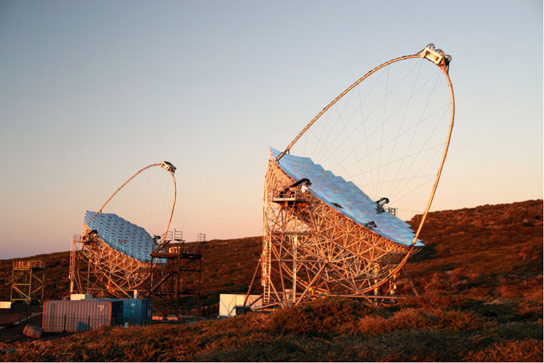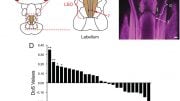
The MAGIC telescopes at La Palma. Credit: The MAGIC Collaboration
Using the MAGIC telescopes at La Palma, astronomers have recorded an extreme event coming from the regions immediately surrounding a supermassive black hole located in the heart of the radio galaxy IC310.
The MAGIC telescopes at La Palma have recorded the fastest gamma-ray flares seen to date, produced in the vicinity of a super-massive black hole. The scientists explain this phenomenon by a mechanism similar to that of producing lightning in a storm. This result, with an important Spanish contribution, is published today in Science.
In the night from 12 to 13 November 2012, the MAGIC gamma-ray telescopes, in the Observatorio del Roque de los Muchachos, were observing the Perseus cluster of galaxies (at a distance of about 260 million light-years) when they detected this extraordinary phenomenon coming from one of the galaxies in the cluster, known as IC310. As many other galaxies, IC310 hosts in its center a super-massive black hole of several million times the mass of the Sun, which sporadically produces intense gamma-ray flares. On this occasion, however, the scientists were astonished by the brevity of the flares, lasting only for a few minutes.
“Relativity tells us that no object can emit for a time shorter than it takes light to cross it. We know that the black hole in IC310 has a size of about 20 light-minutes, approximately three times the distance between the Earth and the Sun. This means that the black hole cannot produce a flare shorter than 20 minutes”, says Julian Sitarek, a Juan de la Cierva researcher at IFAE (Barcelona), and one of the three leading scientists of this work. However, the flares observed in IC310 lasted for less than 5 minutes.
The scientists of the MAGIC Collaboration propose a new mechanism, according to which this “gamma-ray storm” is produced in the vacuum regions created close to the black hole magnetic poles. Very intense electric fields appear in these regions, and are destroyed when they are filled again with charged particles. These particles are accelerated up to close to the speed of light, subsequently transferring part of their energy to the photons they find in their way, thus converting them into gamma rays. The time needed for the light to cross one of these vacuum regions is of a few minutes, in agreement with the observations of IC310. “It is similar to what happens in an electric storm”, explains Oscar Blanch, Ramón y Cajal researcher at IFAE, and Co-Spokesman of the MAGIC Collaboration. “The potential difference is so large that it ends up discharging into a lightning”. In this case, the discharge reaches the highest energies observed in nature, and produces gamma rays. The black hole appears to be immersed in a storm of colossal proportions.
Up until now, the gamma-ray emissions from galaxies such as IC310 were believed to originate in the particle jets produced by the black holes. These jets are detected in many galaxies, and they expand for hundreds of thousands of light-years. When a jet points directly towards the Earth, a relativistic effect, called “apparent superluminous motion”, is produced, due to the similar speeds at which the emitter (jet particles) and the emission (the gamma rays) travel toward us. As a result, the measured intensity of the gamma-ray emission is higher, and its variability faster. However, this explication does not apply to the case of IC310, as its jets do not point at us. The gamma rays must be created practically on the black hole itself.
MAGIC is the present of a young yet fruitful field of science known as Ground-based Gamma-ray Astronomy. Its first steps at Roque de los Muchachos Observatory of the Instituto de Astrofísica de Canarias trace back to the 1980s, with the HEGRA telescopes. The imminent future of the field is the Cherenkov Telescope Array (CTA), to be formed of about 100 telescopes at two observatories (in the Northern and Southern Hemispheres). The Spanish groups of the MAGIC Collaboration have presented a candidacy to build the CTA-North observatory at Roque de los Muchachos or at Teide. This is the best opportunity for Spain to host one of the major global scientific installations that will mark the progress of Astronomy in the years to come.
MAGIC consists of two, 17-m (56-ft) diameter reflective telescopes, built and operated by an international collaboration of 160 scientists from Spain, Germany, Italy, Poland, Switzerland, Finland, Bulgaria, Croatia, Japan, and India. MAGIC is celebrating its tenth anniversary with its fifth scientific publication in Science Magazine. Major contributions of the Spanish groups to the construction of MAGIC include the original camera of one of the telescopes, most of the electronics, and the data center. The success of the experiment has been possible thanks to the quality of the sky at La Palma. The Spanish institutes participating in the experiment are: Instituto de Física de Altas Energías (IFAE, Barcelona), Universidad Autónoma de Barcelona, Universidad de Barcelona, Instituto de Ciencias del Espacio (CSIC, Barcelona), Instituto de Astrofísica de Canarias (IAC, La Laguna), Universidad Complutense de Madrid and Centro de Investigaciones Energéticas, Medioabmientales y Tecnológicas (CIEMAT, Madrid).
Reference: “Black hole lightning due to particle acceleration at subhorizon scales” by J. Aleksić, S. Ansoldi, L. A. Antonelli, P. Antoranz, A. Babic, P. Bangale, J. A. Barrio, J. Becerra González, W. Bednarek, E. Bernardini, B. Biasuzzi, A. Biland, O. Blanch, S. Bonnefoy, G. Bonnoli, F. Borracci, T. Bretz, E. Carmona, A. Carosi, P. Colin, E. Colombo, J. L. Contreras, J. Cortina, S. Covino, P. Da Vela, F. Dazzi, A. De Angelis, G. De Caneva, B. De Lotto, E. De Oña Wilhelmi, C. Delgado Mendez, D. Dominis Prester, D. Dorner, M. Doro, S. Einecke, D. Eisenacher , D. Elsaesser, M. V. Fonseca, L. Font, K. Frantzen, C. Fruck, D. Galindo, R. J. García López, M. Garczarczyk, D. Garrido Terrats, M. Gaug, N. Godinović, A. González Muñoz, S. R. Gozzini, D. Hadasch, Y. Hanabata, M. Hayashida, J. Herrera, D. Hildebrand, J. Hose, D. Hrupec, W. Idec, V. Kadenius, H. Kellermann, K. Kodani, Y. Konno, J. Krause, H. Kubo, J. Kushida, A. La Barbera, D. Lelas, N. Lewandowska, E. Lindfors, S. Lombardi, F. Longo, M. López, R. López-Coto, A. López-Oramas, E. Lorenz, I. Lozano, M. Makariev, K. Mallot, G. Maneva, N. Mankuzhiyil, K. Mannheim , L. Maraschi, B. Marcote, M. Mariotti, M. Martínez, D. Mazin, U. Menzel, J. M. Miranda, R. Mirzoyan, A. Moralejo, P. Munar-Adrover, D. Nakajima, A. Niedzwiecki, K. Nilsson, K. Nishijima, K. Noda, R. Orito, A. Overkemping, S. Paiano, M. Palatiello, D. Paneque, R. Paoletti, J. M. Paredes, X. Paredes-Fortuny, M. Persic, J. Poutanen, P. G. Prada Moroni, E. Prandini, I. Puljak, R. Reinthal, W. Rhode, M. Ribó, J. Rico, J. Rodriguez Garcia, S. Rügamer, T. Saito, K. Saito, K. Satalecka, V. Scalzotto, V. Scapin, C. Schultz, T. Schweizer, S. N. Shore, A. Sillanpää, J. Sitarek , I. Snidaric, D. Sobczynska, F. Spanier, V. Stamatescu, A. Stamerra, T. Steinbring, J. Storz, M. Strzys, L. Takalo, H. Takami, F. Tavecchio, P. Temnikov, T. Terzić, D. Tescaro, M. Teshima, J. Thaele, O. Tibolla, D. F. Torres, T. Toyama, A. Treves, M. Uellenbeck, P. Vogler, R. Zanin, M. Kadler, R. Schulz, E. Ros, U. Bach, F. Kraus and J. Wilms, 28 November 2014, Science.
DOI: 10.1126/science.1256183









Be the first to comment on "MAGIC Telescopes Observe Black Hole Gamma-Ray Lightning"